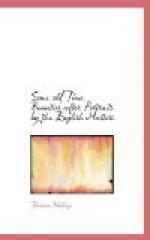Her husband was subject to fits of insanity, and her whole feeling towards him was that of aversion. Cruelty and caprice were the chief components of his character. From his tyranny she fled,—first to her father’s house, but was denied solace there, so sought it elsewhere. She led a somewhat vagabond existence for about nine years, living first with one friend, then with another; thankful for any home, and accommodating herself to any companions. Of this period of her life not much is recorded, save her beauty, for it was shortly after this that her peerless portrait was painted, ere her sorrow and suffering had time to efface the vivacity of youth, but only to give depth to the eyes and interest to the face. She lived in London with her brother Robert until in 1817, when her husband’s death occurred by his falling out of a window when in a state of drunken frenzy. Four months after this she became the second wife of an Irish nobleman of a dashing person and little brains, Charles John Gardiner, second Earl of Blessington, when she was twenty-eight and he was thirty-five years of age. With this marriage came a reversal of her misfortunes. Her generosity, sympathy, and good heart soon prompted the improvement of the conditions of her own family, and in this gave emphatic evidence of that devotedness to duty and friends which became her strongest trait. Her youngest sister, Marianne, was adopted and educated by her, and became her travelling companion, and long afterwards her modest biographer. Her sister Ellen married first, Mr. Home Purves, and afterwards, Viscount Canterbury, speaker of the House of Commons.




